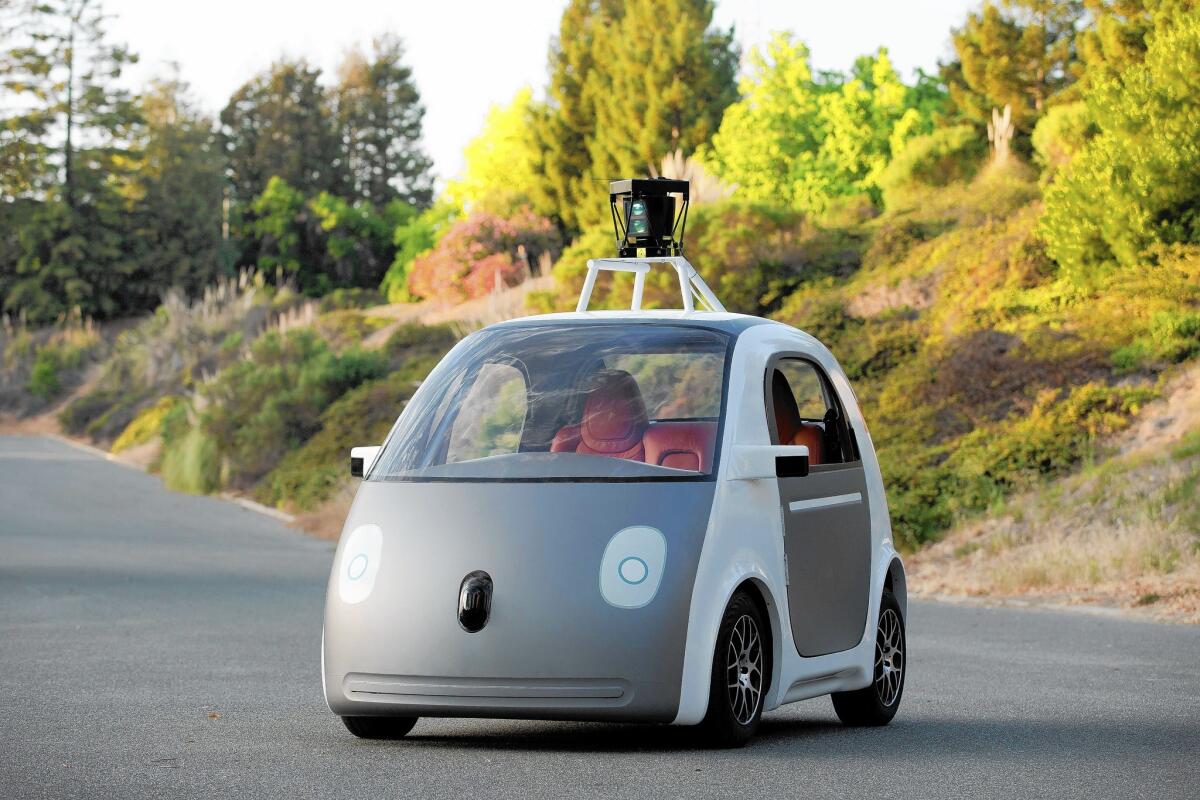Look, Ma, no hands: Google to test 200 self-driving cars

- Share via
General Motors. Toyota. Google?
One of the world’s largest technology companies is getting into the car business — and hoping to turn drivers into passengers. The tech giant announced on its blog Tuesday that it plans to test about 200 of its own two-seat self-driving cars.
“We’ve been working toward the goal of vehicles that can shoulder the entire burden of driving,” the company wrote. “They will take you where you want to go at the push of a button. And that’s an important step toward improving road safety and transforming mobility for millions of people.”
The main goal of the tidy, gumdrop-shaped cars isn’t to push Google into the business of building cars. Instead, the company wants to develop self-driving software that will “improve road safety and help people who can’t drive.”
The testing program will start later this summer, with a handful of primitive prototypes hitting the roads around Google’s Mountain View headquarters.
These early builds will have manual controls for the test drivers to override the cars’ autonomous driving systems, as required by current California law.
But Google plans to build the bulk of the cars as fully autonomous — no steering wheel, no gas or brake pedal.
Inside will be a pair of seats with seat belts, space for your belongings, buttons to start and stop, and a screen showing where the car is going. California law is expected to allow the operation of such vehicles on public roads — with a permit — by the end of this year.
The cars were built with safety in mind. They have sensors that eliminate blind spots and look in every direction for more than 200 yards. The top speed of the first vehicles will be limited to 25 mph.
“We’re going to learn a lot from this experience, and if the technology develops as we hope, we’ll work with partners to bring this technology into the world safely,” Google said on its blog.
The small electric cars were built in Michigan using parts from suppliers to mainstream brands. The electronics and software to control them were assembled in Silicon Valley.
But don’t expect Google to take on the automakers directly.
“The chances of them getting into manufacturing are slim,” Bill Hampton, publisher of AutoBeat Group, said. “I don’t think they want to do that. They want to control the information that will allow driverless cars to operate.... Figuring that out is worth a lot of money.”
Other analysts agreed.
“I can’t imagine Google would want to be in the low-margin manufacturing business,” said Egil Juliussen, the director of research and advanced driver assistance systems at IHS Automotive. “They would be the software provider, which can be the most profitable part of such a car.”
Google’s self-drivers are also notable because their fully autonomous setup, which completely eliminates the driver, leapfrogs the incremental approach mainstream automakers have taken to self-driving cars.
“Google’s announcement is pretty striking,” Juliussen said. “They’re taking the big step, going straight into autonomy without worrying about the intermediate steps.”
Brands such as GM, Volkswagen, Ford, Nissan, Toyota and Mercedes-Benz are already testing self-driving technology. Many high-end luxury cars offer elementary radar systems that allow automatic cruise control, autonomous braking and assistance staying in driving lanes.
But Tuesday’s news probably will speed up development of self-driving cars at many of the largest automakers. These companies probably are working on their own software. But smaller brands like Subaru or Jaguar/Land Rover could look to license Google’s software for their vehicles.
Google’s plan to work on purely autonomous vehicles also turns the car from a product to a service. Self-driving cars could mean transportation for potentially billions of people who are unable to drive because of age, disability or income, Juliussen said. This change in philosophy, from a company of Google’s stature, could ripple through the auto industry, he said.
In addition to potential partnerships with automakers, Google’s self-driving cars could spark micro-loan programs in cities similar to bike-share programs. Users could subscribe for a monthly fee, and take the cars when they needed them for short trips around town.
“Recently we’ve seen an explosion in connected car technology and a growing interest in autonomous driving,” said Karl Brauer, a senior analyst at website Kelley Blue Book. “Google’s intention to begin building cars is the next logical step in the evolution of personal transportation.”
That evolution may happen faster than people think. Many automakers predict they will have fully autonomous cars on the road by 2020. By 2025, as many as 230,000 of these self-drivers could be sold each year around the world, and that number could swell to 11.8 million a decade later, according to a study released this year by Juliussen and IHS Automotive.
As self-driving cars become more common, accident rates are expected to plunge to near zero, since a vast majority of today’s wrecks are caused by human error, the study predicted.
Yet two key obstacles stand in the way of autonomous cars: cost and legislation.
Truly autonomous cars could cost $7,000 to $10,000 more than their manual counterparts when they hit the market in 2020, and probably will be available only as luxury models to begin with.
And U.S. laws have a lot of catching up to do. Currently only four states allow autonomous vehicles on public roads: California, Nevada, Michigan and Florida. Those that do require that a licensed, sober driver be in the driver’s seat at all times, ready and willing to assume control of the vehicle.
Google’s own car hopes to help the laws catch up to the technology.
“Just imagine: You can take a trip downtown at lunchtime without a 20-minute buffer to find parking,” Google’s blog said. “Seniors can keep their freedom even if they can’t keep their car keys. And drunk and distracted driving? History.”
david.undercoffler@latimes.com
Times staff writer Russ Mitchell contributed to this report.







